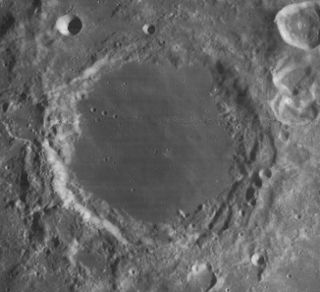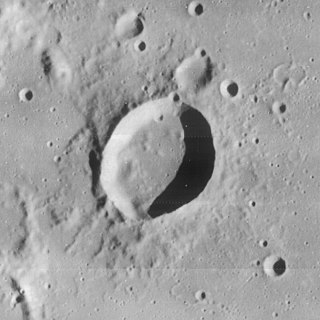
Mare Serenitatis is a lunar mare located to the east of Mare Imbrium on the Moon. Its diameter is 674 km (419 mi).

Deslandres is the heavily worn and distorted remains of a lunar impact crater. It is located to the southeast of the Mare Nubium, in the rugged southern highlands of the Moon. In dimension it is the third-largest crater formation on the visible Moon, being beaten only by Clavius and by the 303-kilometer-diameter walled plain Bailly. The northern and eastern parts of the floor display a relatively level surface, but it is pock-marked with numerous craters. There is a small region of mare material, due to basaltic lava, along the eastern interior floor.

Endymion is a lunar impact crater that lies near the northeast limb of the Moon. It is located to the east of Mare Frigoris and north of Lacus Temporis. To the southwest is the somewhat smaller crater Atlas. Because of its location, Endymion has an oval appearance from foreshortening. Beyond the crater along the lunar limb is the Mare Humboldtianum.

Clausius is a lunar impact crater that is located in the southwest part of the Moon, in the small lunar mare designated Lacus Excellentiae. It is completely enclosed by mare material, although the tiny satellite crater Clausius A lies just to the north. The rim of Clausius is low and sharp, with a slightly oval shape that is longer in the north–south direction. The interior floor has been flooded by basaltic lava, and appears level and featureless with a darker surface that matches the mare surface that surrounds the crater exterior.

Yangelʹ is a small lunar impact crater that is located in the irregular terrain to the north of the Mare Vaporum. Its diameter is 8 km. It was named after Soviet rocketry scientist Mikhail Kuzmich Yangelʹ in 1973. This crater was formerly designated Manilius F.

Macrobius is a prominent lunar impact crater located to the northwest of the Mare Crisium. Its diameter is 63 km. It was named after ancient Roman writer Macrobius. It lies on the southeast edge of the Lacus Bonitatis, a small lunar mare. The somewhat smaller crater Tisserand lies just to the east.

G. Bond is a small lunar impact crater to the south of the Lacus Somniorum, a small lunar mare in the northeast part of the Moon's near side. It was named after the American astronomer George Phillips Bond. It lies to the east of the larger crater Posidonius, and to the south of the flooded crater remnant Hall. The crater is situated in a rugged section of terrain to the northwest of the Montes Taurus mountain region.

Drebbel is a small lunar impact crater named after Cornelius Drebbel that is located to the northeast of the large walled plain Schickard, in the southwestern part of the Moon. Further to the northeast is the Lacus Excellentiae and the small crater Clausius.

Lacus Somniorum is a basaltic plain located in the northeastern part of the Moon's near side. It is located at selenographic coordinates 37.56° N, 30.8° E, and has a diameter of 424.76 kilometers. The name is Latin for Lake of Dreams, a title given to this feature by Giovanni Riccioli. It is the largest of the lunar features designated Lacus.

Lacus Felicitatis is a small patch of the lunar surface that has been inundated by flows of lava, leaving a level patch with a lower albedo than the surrounding ground. It is located in Terra Nivium, an area of continental ground to the north of the Mare Vaporum. About 70–80 km to the northeast of this area are the Montes Haemus, along the southwestern edge of the Mare Serenitatis.

Ina is a peculiar small depression on the Moon, in Lacus Felicitatis. It is D-shaped, 2.9 km × 1.9 km wide and 64 m deep.

Lacus Mortis is a hexagonal-shaped plain of basaltic lava flows in the northeastern part of the Moon's near face. It was formed as a floor-fractured crater during the pre-Imbrian epoch, then flooded during the late Imbrian period. This feature lies just to the south of the elongated Mare Frigoris, being separated by a slender arm of rugged ground and linked at the eastern extreme. To the south is the Lacus Somniorum, separated from this mare by the joined craters Plana and Mason, and a strip of uneven surface.

Lacus Spei is a small lunar mare that is located in the northeastern part of the Moon's near side. To the north is the crater Mercurius and to the west-southwest lies Schumacher.

Lacus Aestatis consists of two relatively small patches of smooth, interconnected lunar mare, located near the western limb of the Moon in the southwestern highlands. It was originally called Mare Aestatis but was renamed at the 1970 IAU convention. The selenographic coordinates of this feature are 15.0° S, 69.0° W, and it lies within a diameter of 90 km. The lake has a combined surface area in the order of 400 km2.

Lacus Temporis is a small lunar mare that is located in the northeastern quadrant of the Moon's near side. The selenographic coordinates of this feature are 45.9°N 58.4°E, and it lies within a diameter of 117 km.

Lacus Oblivionis is a small lunar mare on the surface of the Moon. It is located at 21.0° S, 168.0° W and is 50 km in diameter. The name was adopted by the IAU in 1976.

Lacus Veris is a small lunar mare on the Moon. In selenographic coordinates, the mare centered at 16.5° S, 86.1° W and is approximately 396 km long. The mare extends along an irregular 90° arc from east to north that is centered on the Mare Orientale, covering an area of about 12,000 km2. Author Eric Burgess proposed this mare as the location of a future manned lunar base, citing a 1989 study performed at the NASA Johnson Space Center.

Volcanism on the Moon is represented by the presence of volcanoes, pyroclastic deposits and vast lava plains on the lunar surface. The volcanoes are typically in the form of small domes and cones that form large volcanic complexes and isolated edifices. Calderas, large-scale collapse features generally formed late in a volcanic eruptive episode, are exceptionally rare on the Moon. Lunar pyroclastic deposits are the result of lava fountain eruptions from volatile-laden basaltic magmas rapidly ascending from deep mantle sources and erupting as a spray of magma, forming tiny glass beads. However, pyroclastic deposits formed by less common non-basaltic explosive eruptions are also thought to exist on the Moon. Lunar lava plains cover large swaths of the Moon's surface and consist mainly of voluminous basaltic flows. They contain a number of volcanic features related to the cooling of lava, including lava tubes, rilles and wrinkle ridges.



















